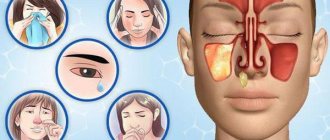Autumn and winter are the period of colds and the spread of viral infections. It is during this time that the incidence rate increases significantly. For some people, distinguishing the flu from a cold can be difficult. Although these two diseases are similar in symptoms, course and even cause, treatment for the flu and colds can be very different. And incorrectly prescribed medications can only worsen the situation.
How to distinguish the flu from a cold - we'll figure it out in this article.
How is the flu different from a cold?
- Onset of the disease . Flu symptoms develop rapidly. And it progresses quickly in the body.
The source of influenza is sick people during the incubation period or the height of the disease. The disease is transmitted by airborne droplets when sneezing, coughing, shaking hands, and also through dirty food (it has not been thermally processed enough). The infection begins to manifest itself in the period from 4 hours to 3 days. In general, the disease goes away in 5-7 days.
A cold is a disease of the body associated with hypothermia. A cold develops gradually, progressively, and painful symptoms appear within a day or two. It is usually easy to treat. But in advanced forms it can develop into other more severe diseases.
- Temperature . With the flu, there is a high body temperature, which can reach 39-40 degrees. With a cold, the temperature usually remains at the standard level.
- Weakness . People with a cold often ignore symptoms such as cough and runny nose, thinking that it will “go away on its own” with time. A cold can be carried on your feet, although it is undesirable.
But during the flu, the patient immediately realizes that he is sick; often he cannot even have the strength to get out of bed. Aches all over the body, severe headache, fever - these symptoms cannot be confused with anything else.
- Cough and runny nose . During the flu, these symptoms do not appear immediately (only after 5 days), and may not appear at all. With a cold, a debilitating cough, sore throat when swallowing and a runny nose are noted.
- Red eyes, itching and watery eyes . The picture of the flu is complemented by red eyes, severe weakness, fever, and bursting blood vessels in the nose. And in severe forms, even convulsions, vomiting, rapid heartbeat, and lack of air are possible.
When you have a cold, your eyes do not turn red or water, and if this happens, it is more likely to indicate a bacterial infection.
When relief comes
Sometimes this symptom appears suddenly, more often it increases along with signs of fever. With a mild course of the disease, a severe headache usually continues in the first 1–2 days. After this time, it gradually weakens, the temperature drops slightly and catarrhal symptoms develop: a wet cough and runny nose. Slight dizziness, dazedness and a feeling of heaviness may continue for several days.
In people who are seriously ill with the disease, the pain is protracted, haunts them around the clock, does not respond well to painkillers, and leaves them in their sleep for a short time. From the first hours until complete recovery, patients feel completely overwhelmed, cannot leave their bed for a long time, are unable to work or eat normally. In such cases, the headache may continue to hurt for up to 2-3 weeks.
Why is it necessary to distinguish between these diseases?
The group of people with weakened immune systems includes pensioners and children, people with chronic diseases. This means that their immune system is most susceptible to attack by pathogens. An incorrect diagnosis can lead to deterioration in the functioning of the entire body and incorrect treatment.
Due to influenza, the natural functions of the immune system are weakened, against the background of this, other infections can join and develop. These are mainly respiratory tract infections: the lungs are affected by streptococcal or staphylococcal flora. This contributes to the development of pneumonia, pulmonary hemorrhage, and edema.
Influenza in adults can be complicated by the development of sinusitis, sinusitis, pericarditis and acute cardiovascular failure. Influenza in children is complicated by otitis media, focal pneumonia, and bronchitis.
Diagnosis of flu and colds
If you suspect a disease, you should seek help from a doctor. For adults - a therapist, for children - a pediatrician. The consultation takes place in several stages.
- Initial examination. The doctor will ask you questions about your health, review your medical history, and refer you for tests and diagnostics. After a private consultation, the therapist prescribes an ultrasound of internal organs and laboratory tests to detect viruses and infections.
- Establishing diagnosis. After collecting anamnesis, the specialist will identify the disease based on the results obtained. He will tell you about the causes of your condition, prescribe treatment with various methods and drugs, or refer you for hospitalization.
- If necessary, the therapist will refer you to a specialist for further examination.
As for the examination of the child by the pediatrician, parents must be present. This helps the doctor quickly find a common language with the patient. Initially, the pediatrician listens to the lungs, measures the child’s body temperature, and examines the throat for inflammation.
The specialist listens to parents' complaints about the child's health. After this, it is necessary to undergo an examination to diagnose the disease. The pediatrician will order a blood/urine test, as well as additional tests if necessary (scraping, x-ray, bronchoscopy). At a follow-up consultation, the specialist will make a diagnosis, prescribe medication, or refer you to a specialized specialist.
Headache due to infection
Most often this happens with acute respiratory viral infections and influenza. The headache begins against the background of typical signs of intoxication: chills, elevated body temperature, muscle aches, pain in the eyes.
In most cases, headaches due to flu and colds are mild. It is localized in the frontal part of the head, near the temples and brow ridges. The patient may feel tired, weak, and have muscle pain. It is necessary to combat such headaches with the help of antipyretics.
In infectious diseases, the localization of headache is recorded mainly in the frontal part of the head. She's usually dumb. Headaches should be taken seriously as they can often indicate the presence of a meningococcal infection. The most dangerous forms of this disease are meningococcemia (infection of microorganisms in the blood) and meningococcal meningitis (damage to the meninges). And in such cases, headache is the main symptom. It is worth emphasizing that meningococcal infection is extremely dangerous. After all, there are fulminant forms of the disease that lead to death in a few hours. Therefore, timely diagnosis of the disease is the key to successful treatment.
Dengue fever also causes widespread pain. In this case, retro-orbital headache is especially severe, which is accompanied by unpleasant sensations in the joints and muscles. Because of this, a person cannot bend his legs normally when walking and a peculiar gait appears (it is called the gait of a dandy, a dandy). Another characteristic manifestation of this condition is a puffy and hyperemic face, injected sclera, and hemorrhagic rash. pain in the joints and muscles lasts for three to eight weeks.
The following symptoms indicate an excessive risk of headache:
- vomiting without feeling of relief;
- lack of relief after taking painkillers or antipyretics;
- pain in the neck, which makes it painful to lift your head from the pillow when lying down;
- disturbances of consciousness;
- the appearance of a rash in the form of dark red spots.
If you have these symptoms, you should immediately consult a doctor, who should carry out an appropriate diagnostic examination. This may include laboratory blood tests, magnetic resonance imaging, and other procedures. Timely detection of the disease will allow timely treatment to begin and avoid unpleasant consequences.
Headache is a fairly common symptom of infectious diseases. Basically, it occurs as a result of intoxication - the effect of microorganism toxins on the body of a sick person. Most often this happens with acute respiratory viral infections and influenza. The headache begins against the background of typical signs of intoxication: chills, elevated body temperature, muscle aches, pain in the eyes.
In most cases, headaches due to flu and colds are mild. It is localized in the frontal part of the head, near the temples and brow ridges. The patient may feel tired, weak, and have muscle pain. It is necessary to combat such headaches with the help of antipyretics.
In infectious diseases, the localization of headache is recorded mainly in the frontal part of the head. She's usually dumb. Headaches should be taken seriously as they can often indicate the presence of a meningococcal infection. The most dangerous forms of this disease are meningococcemia (infection of microorganisms in the blood) and meningococcal meningitis (damage to the meninges). And in such cases, headache is the main symptom. It is worth emphasizing that meningococcal infection is extremely dangerous. After all, there are fulminant forms of the disease that lead to death in a few hours. Therefore, timely diagnosis of the disease is the key to successful treatment.
Dengue fever also causes widespread pain. In this case, retro-orbital headache is especially severe, which is accompanied by unpleasant sensations in the joints and muscles. Because of this, a person cannot bend his legs normally when walking and a peculiar gait appears (it is called the gait of a dandy, a dandy). Another characteristic manifestation of this condition is a puffy and hyperemic face, injected sclera, and hemorrhagic rash. Joint and muscle pain lasts three to eight weeks.
The following symptoms indicate an excessive risk of headache:
- vomiting without feeling of relief;
- lack of relief after taking painkillers or antipyretics;
- pain in the neck, which makes it painful to lift your head from the pillow when lying down;
- disturbances of consciousness;
- the appearance of a rash in the form of dark red spots.
If you have these symptoms, you should immediately consult a doctor, who should carry out an appropriate diagnostic examination.
This may include laboratory blood tests, magnetic resonance imaging, and other procedures. Timely detection of the disease will allow timely treatment to begin and avoid unpleasant consequences. Author: K.M.N., Academician of the Russian Academy of Medical Sciences M.A. Bobyr
How are colds and flu treated?
Hospital mode
The first thing the doctor will prescribe for such a disease is bed rest. Carrying an illness on your feet is extremely dangerous for both you and those around you. The influenza virus is highly contagious. Everyone you come into contact with will also get sick. You, in turn, risk getting a bacterial complication of the flu.
It is also necessary to adhere to a certain diet: try to drink as much warm drink as possible (herbal teas, milk with honey, berry fruit drinks, water), do not eat heavy fried foods. If you or your child suffering from a disease does not want to eat, there is no need to force it. Decreased appetite is a common symptom of the disease.
Drug therapy
First of all, antiviral drugs are prescribed for influenza and colds , which inhibit the vital activity and spread of the virus inside the human body. Such medications are prescribed for severe or moderate severity of the disease. The drug is most effective in the first days of the disease.
Antipyretics are used only at very high temperatures to help the body cope with the fever and prevent complications from developing. These drugs also have an anti-inflammatory effect.
Antibiotics for colds are taken only after a doctor's prescription. When, against the background of the development of influenza, an acute bacterial infection appears that the body cannot cope with on its own. Important: if you start taking antibiotics, the course cannot be interrupted.
Antihistamines relieve the unpleasant consequences of the disease, such as redness, itching, lacrimation, swelling of the nasopharynx and nasal discharge.
Immunostimulants help strengthen the body's defenses and help the immune system independently repel attacks from viruses and bacteria.
Drops for a runny nose relieve swelling of the mucous membrane, allow the nose to breathe normally and prevent the occurrence of microbial complications. However, the drug should not be taken for more than 5 days, because there is a risk of chronic swelling of the mucous membrane.
Symptoms relieved by NSAIDs
Nonsteroidal anti-inflammatory drugs are unique due to the combination of pharmacological properties: anti-inflammatory, antipyretic and analgesic (pain reliever)6.
Inflammation
Inflammation is a protective reaction of the body in response to various damaging factors. NSAIDs reduce inflammation regardless of the cause and location of the inflammatory process10.
Heat
infectious agents enter the body . At the same time, there is a rise in temperature, increased heart rate, and increased blood flow, which leads to the suppression of viruses and bacteria and stimulation of the immune system6. However, the system sometimes fails - during the maximum temperature increase, overheating and damage to the body is possible. This is especially dangerous for people with poor health, with heart and vascular diseases, for the elderly and children6.
On the other hand, a sharp decrease in elevated temperature can lead to collapse (sudden cardiovascular failure), which is also very dangerous for the body6.
NSAIDs smoothly reduce temperature by acting directly on the thermoregulation center in the brain - heat production decreases and heat transfer increases6. Also, these drugs only work during fever and do not affect normal body temperature7. This is why NSAIDs are the symptomatic drugs of choice for high fevers such as colds and flu .
Pain
Headache and muscle pain are manifestations of ARVI, which may require taking non-steroidal drugs3. The pronounced analgesic effect of these drugs for colds and flu is due to the fact that they inhibit the synthesis of prostaglandins - substances that increase pain sensitivity7.
When choosing medications, it is important to focus on drugs with minimal risk of side effects11.
Motrin® is a non-steroidal anti-inflammatory drug that can be used to treat febrile conditions during colds and flu , as well as as part of complex therapy for infectious and inflammatory diseases of the ear, nose and throat with severe pain (pharyngitis, tonsillitis, otitis media)8. It is an over-the-counter naproxen-based drug that has analgesic, antipyretic , and anti-inflammatory effects8,9.
The advantage of naproxen is that it is not inferior to other NSAIDs in terms of analgesic and anti-inflammatory effects, but at the same time causes fewer side effects9. The duration of the analgesic effect of naproxen is up to 12 hours*.
Motrin® is used to reduce pain, inflammation, reduce elevated body temperature and does not affect the development of the underlying disease8.
Up to contents
Prevention of flu and colds
The most reliable way to prevent influenza is vaccination. The flu shot is effective, but does not provide long-term immune protection, so vaccination should be done annually. Regular flu vaccination increases the production of antibodies to the virus.
The vaccine has no side effects, and the improved composition protects against mutated strains of the virus. Timely vaccination prevents infection. Even if infected, the disease will be mild.
After getting a flu shot, your temperature may rise to 37.5℃, you may experience chills, sweating, a general feeling of weakness and poor appetite. Redness, slight swelling, itching and pain may be observed at the injection site. This is an indication that your body is developing immunity to the flu. After vaccination, it is strictly forbidden to visit a bathhouse/sauna, swim in open water, engage in tiring physical activity, or drink alcohol.
Contraindications to the flu vaccine
- at least 6 months have not passed since the last vaccination;
- bronchial asthma;
- allergic reactions;
- iron deficiency;
- diseases of the respiratory system in acute or chronic form;
- allergic reaction to chicken protein;
- heart failure;
- endocrine diseases;
- blood pathologies;
- first trimester of pregnancy;
- severe renal failure;
- period of exacerbation of chronic diseases.
To prevent flu and colds, follow a few simple rules:
- Strengthen your immune system. Exercise more often or give your body light exercise. Take a walk in the fresh air, this will saturate your lungs with oxygen.
- Avoid hypothermia. This occurs due to a sharp temperature change and the action of the air conditioner.
- Use antibacterial agents, especially during cold season.
- Eat a balanced diet. This will provide the body with the necessary microelements.
Where to get diagnosed and treated for flu and colds in Krasnoyarsk?
This can be done at the Medunion private medical clinic.
Is a child or an elderly person sick? Then do not wait to see a doctor, but simply call a specialist at home. It's not only fast, but also very convenient! The specialist will examine the patient in a familiar environment, prescribe tests, and prescribe the necessary treatment. And the nurse will take samples or vaccinate you.
Sign up for a medical appointment and take care of the health of your loved ones. You can do this in any way convenient for you - online or by phone on the website. The cost of an initial consultation with a doctor starts from 1100 rubles.
Preventing headaches due to influenza
There are a number of preventive measures that prevent you from contracting the insidious flu:
- firstly, during an epidemic, avoid places where many people gather;
- secondly, wash your hands thoroughly with soap and water after visiting the street, it is advisable to rinse your nose with water and sea salt;
- thirdly, disinfect gadgets, including mobile phones;
- fourthly, lubricate the nasal mucosa with oxolinic ointment before you go outside (it fights viruses);
- fifthly, ventilate the rooms where you spend most of the day more often (viruses love dry air).
It's better not to take risks with the flu. Even gauze bandages will not help, because the virus can penetrate through the pores of the gauze. But it still makes sense to wear them when you have to come into contact with people.








